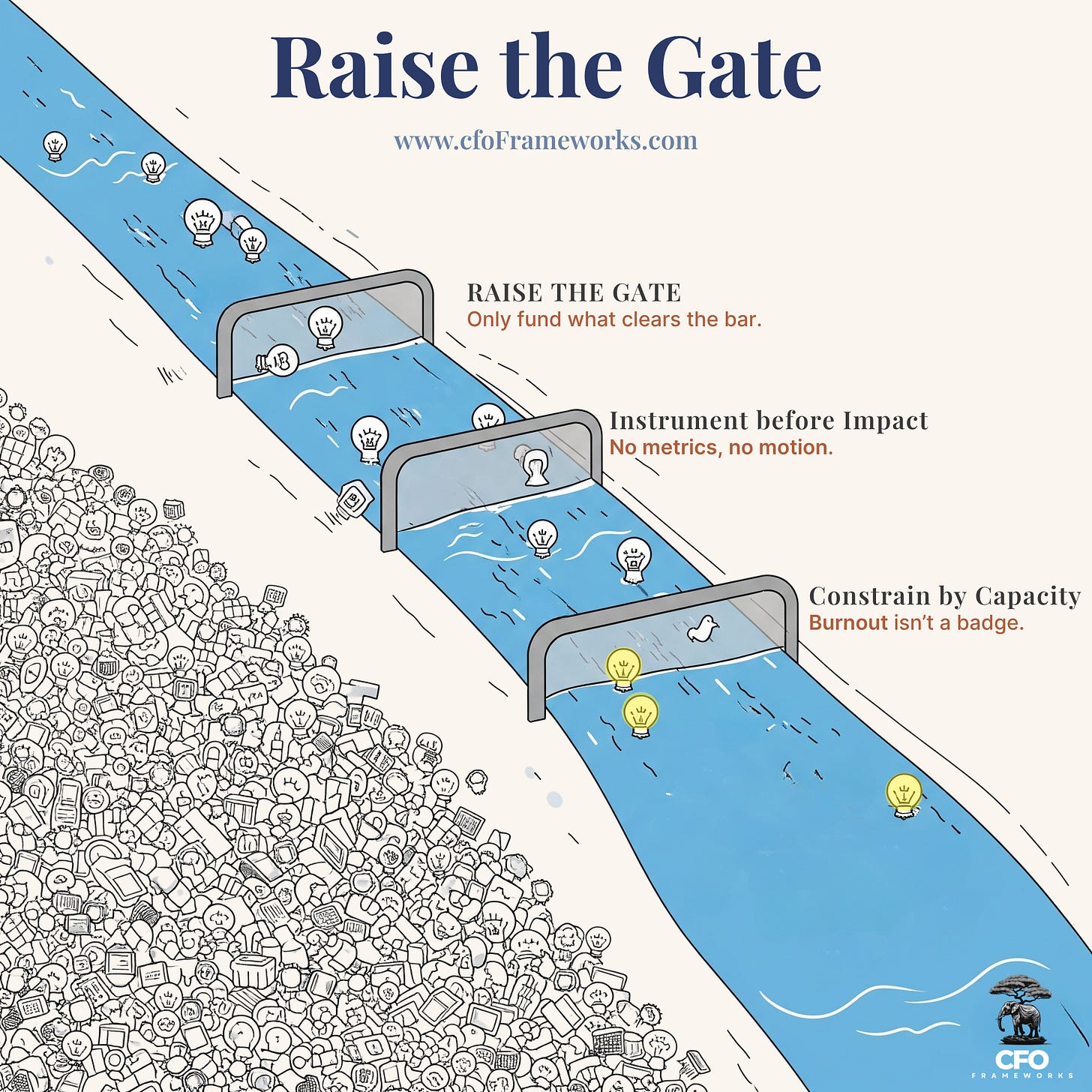Upstream or Underwater
Why unchecked ideas drown your team - and how smart leaders raise the gate
There’s an old story about a village by a river.
One day, a child is spotted floating downstream, struggling to stay above water. A villager dives in to save them — just in time. But then another child appears. And another. Soon, the entire village is working around the clock to pull children from the river.
They become faster, more coordinated, even heroic.
Until someone finally asks:
“Who’s throwing them in upstream?”
Most companies operate like that village.
Growth initiatives flow in with urgency and ambition — each one well-intentioned, but often half-baked. The burden of defining success, aligning systems, and managing execution falls downstream to operations.
Ops scrambles to measure. To instrument. To fix. They swim harder. They build rafts. They get faster. But they’re still in the river.
It feels productive. It feels responsive. But it’s fast…and Fast is Fragile.
There’s a better way. The solution isn't to slow down; it's to get smarter about how and when we move.
Be quick. Don’t hurry.
The best operators move fast, but only after they’ve filtered well. They don’t optimize chaos. They prevent it.
The Framework: Raise the Gate
A three-part model for upstream filtration — to protect your systems, your teams, and your outcomes.
1. Raise the Gate
Only fund what clears the bar.
Before an initiative earns a green light, it should be able to answer a few simple questions:
What problem are we solving?
Who owns the outcome?
How will we measure success?
What systems or teams are impacted?
If a proposal can’t clear that bar, it doesn’t move forward.
Most failed projects didn’t die in execution. They died the moment we said yes without asking enough.
Think of the countless products launched with fanfare and met with crickets, or the improvement initiatives that only served to set the team further back, all because the core problem and desired outcome weren't clearly defined upfront.
2. Instrument Before Impact
No metrics, no motion.
Measurement isn’t a cleanup job. It’s a launch requirement.
If you can’t define success, align on KPIs, and build the instrumentation before go-live, the initiative isn’t ready. Full stop.
Because if you don’t know what good looks like, you can’t tell whether you’re getting closer to it. Like launching a marketing campaign without tracking the source of leads, leaving you to guess whether it was effective.
Every measurement is both a snapshot and a signal — it tells you where you are and helps you decide what matters.
Shipping without observability doesn’t make you agile.
It makes you blind — and too confident to know it.
3. Constrain by Capacity
Burnout isn’t a badge.
Operational bandwidth isn’t infinite. It’s a fixed asset, and one of your most fragile.
If you don’t protect it, your team will look busy but finish nothing.
When too much flows through at once, quality drops, accountability blurs, and learning is impossible.
Every initiative you add is a bet. And every bet spreads your attention thinner.
The real risk isn’t doing too little — it’s starting too much and finishing none of it well. Less beats more.
Limit concurrent work. Prioritize ruthlessly. Build in time to regroup, refine, and repair.
When everything flows through, everything breaks eventually.
Common Pitfalls
These are the reflexes that kill clarity before you even begin:
“But We Need to Move Fast!”
Speed without clarity is just motion. You’ll ship more — and finish less.
The fastest way to get somewhere meaningful is to know where not to go.
“We’ll Figure Out Metrics Later.”
That’s not agility. That’s amnesia.
If you don’t define success upfront, you’ll rationalize failure after the fact.
“Everyone Else Is Doing It.”
FOMO isn’t a strategy.
Most of the initiatives that appear fast from the outside are quietly failing from the inside.
Execution is a visibility game — don’t trust the surface.
“This Will Slow Us Down.”
Yes. That’s the point.
Constraints slow you down at the start, so you don’t stall out in the critical execution phase.
The prep you resist now is the rework you regret later.
Raise the gate — or drown in do-overs.
💼 A Tool to Raise the Gate
Want to bring this thinking into your org?
I’ve created a Strategic Initiative Proposal Template that reflects these same principles — problem clarity, ownership, instrumentation, and constraint.
You can download it here: 👉 Strategic Initiative Template
It’s built to help your team say yes only when the initiative is truly ready — and say not yet with clarity, not confusion.
Making the Shift
The village didn’t build a better rescue system. It went upstream.
And what once felt like chaos became quiet.
You can only swim against the current for so long before you drown. You can’t solve downstream what should have been stopped upstream.
The best operators don’t just move faster — they design better flow.
They don’t rescue. They filter.
They raise the gate.
And once the gate is in place, everything changes:
Fewer emergencies
Clearer metrics
More work that actually finishes
It starts with a single move:
Pick one team that’s overwhelmed.
Trace the noise back to its source.
Apply the filter before the flood.
Need help?
Use this proposal template to set the bar.
Make clarity the cost of entry.
You don’t need to say yes fåster.
You need to say yes later — and better.
Start upstream.





Good reminder to everyone of us. In my experience, unclear definition of impact and ignoring resource constraints.